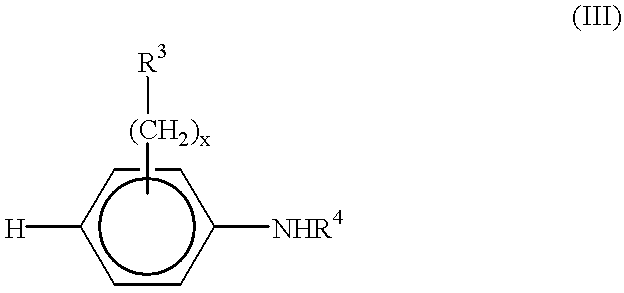End-functionalized aniline-based oligomers, corrosion-resistant copolymers and methods of making the same
a technology of aniline-based oligomers and copolymers, which is applied in the field of end-functionalized aniline-based oligomers, corrosion-resistant copolymers and methods of making the same, can solve the problems of difficult general application of these methods for synthesizing polyaniline and its derivatives, adverse health and environmental effects of chromium-containing compounds, and achieves the effect of reducing the oxidation potential
- Summary
- Abstract
- Description
- Claims
- Application Information
AI Technical Summary
Benefits of technology
Problems solved by technology
Method used
Image
Examples
example 2
Aniline Trimer Synthesis Procedure: 1,4-phenylenediamine in the amount of 0.86 g (8 mmol) was dissolved in a solution of 100 ml of aqueous 1M hydrochloric acid and 40 ml ethanol. The solution was then cooled to about -5.degree. C. in a NaCl-crushed ice bath. To this solution, 1.8 g (8 mmol) of ammonium persulfate was added in one portion with stirring under air. After about 5 minutes, the reaction solution became dark brown and 1.5 ml (16 mmol) of doubly distilled aniline was added quickly. Several minutes later, a blue particle suspension was formed and the reaction mixture was stirred vigorously for an additional 30 min.
The solid product, n,n'-bis(4'aminophenyl)-1,4-quinonenediimine, was collected by filtration through a Buchner funnel under reduced pressure and washed with 30 ml of 1M hydrochloric acid followed by 80 ml of distilled water. The product was then treated with 40 ml of 1M aqueous solution of ammonium hydroxide for 1-2 h. The mixture was filtered under reduced pressur...
examples 3-6
For Examples 3-6, the same procedure used for forming the trimer n,n'-bis(4'aminophenyl)-1,4-quinonenediimine above from 1-phenylenediamine of Example 2 was used to synthesize derivatives of the trimer in accordance with the following reaction scheme and compounds: ##STR17##
According to the above reaction mechanism, in Example 2 above, X'.dbd.X".dbd.Y'.dbd.H and the product is formed in accordance with Formula A. In Example 3, for both the reactant and product according to Formula A, X'.dbd.CH.sub.3 and X".dbd.Y'.dbd.H. In Example 4 for the reactant and product according to Formula A, X'.dbd.X".dbd.CH.sub.3 and Y'.dbd.H. In Example 5 for the reactant and product according to Formula A, X'.dbd.Cl, X".dbd.Y'.dbd.H. For Example 6, for the reactant and the product according to Formula A, X'.dbd.X".dbd.H and Y.dbd.CH.sub.3.
In a subsequent reaction, the compound of Example 2 was reduced with hydrazine under a nitrogen atmosphere yielded a while solid which was characterized as n,n'-bis (4...
examples 7-10
The same procedure as that of Examples 2-4 and 6 was undertaken respectively in Examples 7-10, however, in the aniline trimer synthesis, 16 mmol of ammonium persulfate oxidant was added, such that the molar ratio of the ammonium persulfate to aniline or the aniline derivative of Example 2-5 was 1:1 instead of 1:2. The effect of the change in yield is shown in Table 1. All of the compounds of Examples 2-10 were characterized by infrared, electronic absorption, exact mass, and NMR spectroscopy and the results were consistent with the proposed structures. All of the trimers exhibited excellent solubility in most common organic solvents. The wavelengths of maximum ultraviolet absorption (Maximum .lambda.) were measured in various solvents such as dimethylformamide (DMF), tetrahydrofuran (THF) and dichloromethane (CH.sub.2 Cl.sub.2).
[t1]
PUM
| Property | Measurement | Unit |
|---|---|---|
| molecular weight distribution | aaaaa | aaaaa |
| polydispersity | aaaaa | aaaaa |
| polydispersity | aaaaa | aaaaa |
Abstract
Description
Claims
Application Information
 Login to View More
Login to View More - R&D
- Intellectual Property
- Life Sciences
- Materials
- Tech Scout
- Unparalleled Data Quality
- Higher Quality Content
- 60% Fewer Hallucinations
Browse by: Latest US Patents, China's latest patents, Technical Efficacy Thesaurus, Application Domain, Technology Topic, Popular Technical Reports.
© 2025 PatSnap. All rights reserved.Legal|Privacy policy|Modern Slavery Act Transparency Statement|Sitemap|About US| Contact US: help@patsnap.com



